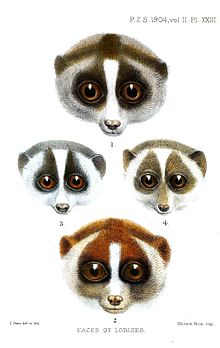Loris
| Lorises Temporal range: Miocene to present
| |
|---|---|

| |
| Joseph Smit's Faces of Lorises (1904) | |
| Scientific classification | |
| Domain: | Eukaryota |
| Kingdom: | Animalia |
| Phylum: | Chordata |
| Class: | Mammalia |
| Order: | Primates |
| Suborder: | Strepsirrhini |
| Family: | Lorisidae |
| Subfamily: | Lorinae Gray, 1821[1] |
| Genera | |
| |
| Synonyms | |
| |
Loris is the
strepsirrhine mammals of the subfamily Lorinae[1] (sometimes spelled Lorisinae[2]) in the family Lorisidae. Loris is one genus in this subfamily and includes the slender lorises, Nycticebus is the genus containing the slow lorises, and Xanthonycticebus is the genus name of the pygmy slow loris
.
Description
Lorises are
]Lorises, like most strepsirrhines, have a special adaptation called a "toothcomb" in their lower front teeth, which they use for grooming their fur and even injecting their venom.[5]
Female lorises practice infant parking, leaving their infants behind in trees or bushes. Before they do this, they bathe their young with
Taxonomic classification
The family Lorisidae is found within the
infraorder Lemuriformes and superfamily Lorisoidea, along with the family Galagidae, the galagos. This superfamily is a sister taxon of Lemuroidea, the lemurs. Within Lorinae, there are ten species (and several more subspecies) of lorises across three genera:[1]
- Family Lorisidae
- Subfamily Perodicticinae
- Subfamily Lorinae
- Genus Loris
- Gray slender loris, Loris lydekkerianus
- Highland slender loris, L. lydekkerianus grandis
- Mysore slender loris, L. lydekkerianus lydekkerianus
- Malabar slender loris, L. lydekkerianus malabaricus
- Northern Ceylonese slender loris, L. lydekkerianus nordicus
- Red slender loris, L. tardigradus
- Dry Zone slender loris, L. tardigradus tardigradus
- Horton Plains slender loris, L. tardigradus nyctoceboides
- Gray slender loris, Loris lydekkerianus
- Genus Xanthonycticebus[7]
- Pygmy slow loris, X. pygmaeus
- Genus Nycticebus
- Bangka slow loris, Nycticebus bancanus
- Bengal slow loris, N. bengalensis
- Bornean slow loris, N. borneanus
- Sunda slow loris, N. coucang
- Javan slow loris, N. javanicus
- Kayan River slow loris, N. kayan
- Philippine slow loris, N. menagensis
- Sumatran slow loris, N. hilleri
- †? N. linglom (fossil, Miocene)
- Genus
References
- ^ OCLC 62265494.
- S2CID 29045930.
- ISBN 978-0-8018-6251-9.
loris OR lorises.
- ^ ISBN 978-1337099820.
- S2CID 1948088.
- ^ "Orangutan Ecology". Orangutan Foundation International. Retrieved 2014-01-14.
- S2CID 247649999.
External links
![]() Data related to Loris at Wikispecies
Data related to Loris at Wikispecies
